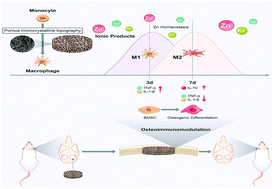Sequential macrophage transition facilitates endogenous bone regeneration induced by Zn-doped porous microcrystalline bioactive glass†
Abstract
Macrophages play an important role in the immune microenvironment during bone healing, and sequential macrophage phenotypic transition could achieve superior osteogenic outcomes. Microcrystalline bioactive glasses (MCBGs) with osteoimmunomodulatory effects show potential in bone tissue regeneration. Zinc (Zn) has been approved to coordinate innate and adaptive immunity. Therefore, in this study, different amounts of ZnO were incorporated into microcrystalline bioactive glass to improve its immunomodulatory ability. The effect of Zn-MCBG ionic extracts on macrophage transition was studied, and the 5Zn-MCBG extracts could orchestrate sequential M1-to-M2 macrophage transition and promote the expression of proinflammatory and anti-inflammatory genes and cytokine expression to induce human bone marrow stromal cells (hBMSCs) osteogenic differentiation in vitro. Macroporous Zn-MCBG scaffolds containing mesopores were fabricated and showed good cell adhesion and feasible apatite formation when immersed in SBF in vitro. Furthermore, a rat calvarial defect model was used to confirm that the Zn-MCBG scaffold could modulate macrophage phenotypic transition and create a desirable osteogenic microenvironment to promote osteogenesis in vivo.



 Please wait while we load your content...
Please wait while we load your content...